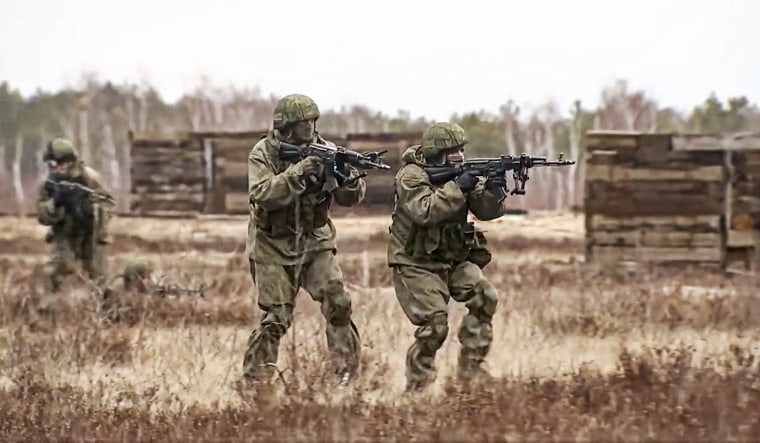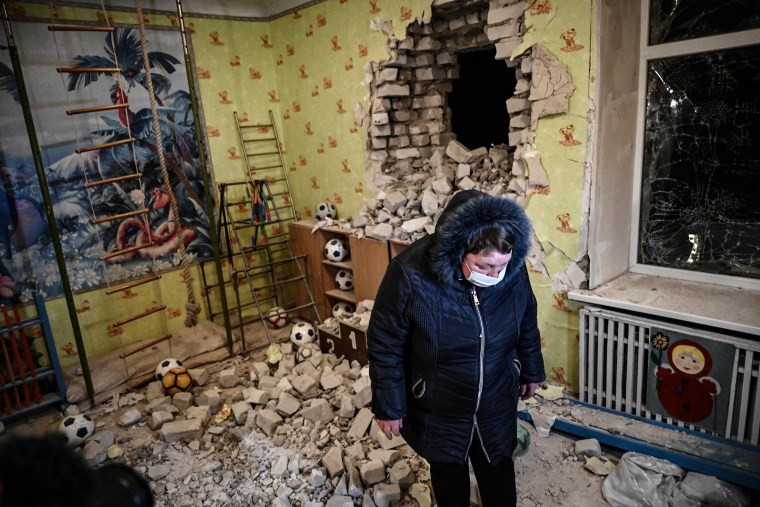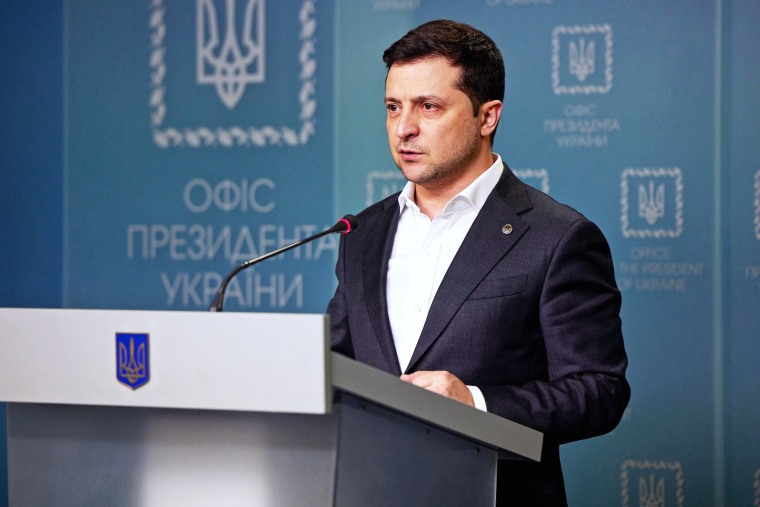For months, the world was left guessing about what Russian President Vladimir Putin was up to with Ukraine.
Western leaders warned that an invasion was likely as he deployed some 150,000 troops around the country’s borders and issued security demands to the United States and NATO that were never likely to go anywhere.
Those fears became reality this week, when the Russian leader launched a broad invasion. Soon, air-raid sirens wailed in Kyiv and battles raged across the country.
NBC News looks at what’s behind Russia’s attack on Ukraine, which has left Europe facing perhaps its gravest security crisis since World War II.
How the buildup began
In late 2021, military analysts helped draw the world’s attention to a concerning picture developing on Ukraine’s borders: Russia was massing thousands of troops around its neighbor.
A similar buildup, although on a smaller scale, first unnerved the world in April. Moscow withdrew after weeks of tensions.
But as the Russian military buildup intensified, the U.S. and its allies warned that Putin could launch a devastating attack on Ukraine as early as January. All the while, the Kremlin denied it had any such plans.
In December, it offered a glimpse of what it might want.
Putin laid out a series of bold security demands that would not only stop NATO’s expansion to the east but push it back, viewing the drift of former Communist countries and Soviet republics into Washington’s orbit as an existential threat to Russia. Though there was some dialogue on lower-level issues, the central demands were deemed nonstarters by the U.S. and its NATO allies.
A flurry of diplomatic activity to find middle ground followed, but resulted in no breakthroughs.
Putin made it clear he felt the West had failed to meet Russia’s demands, but left the world hanging about what he might do next.
Ratcheting up tensions, Moscow launched massive military drills with close ally Belarus, to Ukraine’s north, amassing an estimated 30,000 troops and heavy military equipment — the biggest such deployment to the former Soviet state since the Cold War, according to NATO.

It raised fears that Russia could use the pretext of the exercises to launch a direct attack on Kyiv, Ukraine’s capital, from the north.
Moscow tried to signal it was pulling some troops back, but the West rejected the suggestion and said Russia was increasing its presence instead. Weeks of ominous intelligence assessments culminated in President Joe Biden making it clear that the U.S. believed Putin had made the decision to invade.
Ukraine’s leaders sought to play down the threat and calm its citizens, but events soon took a turn.
A pretext for a power grab?
A significant spike in shelling in eastern Ukraine, where Moscow-backed separatists had been fighting Ukrainian forces since 2014 in a conflict that cost an estimated 14,000 lives, intensified concerns that the Kremlin was trying to create a pretext for an attack.
The industrial region of Donbas, internationally recognized as Ukrainian but partly controlled by the separatists, quickly became the flashpoint in a broader standoff that the U.S. and its allies had feared.
Kyiv pointed to artillery fire on a kindergarten in its territory and analysts questioned why it would intensify a long-running conflict while surrounded on three sides by Russian forces.

But the leaders of the two breakaway regions in eastern Ukraine, the self-proclaimed “Donetsk People’s Republic” and “Luhansk People’s Republic,” ordered their residents to evacuate to Russia, warning of an imminent attack by the Ukrainian army — which Kyiv adamantly denied. Russian state media began to deliver a flood of public reports about alleged “atrocities” taking place in the region, which Putin has repeatedly called a “genocide.” International monitors categorically deny that’s the case.
Just days later, Putin conducted apparently staged consultations with senior Kremlin officials.
One by one, they lined up to tell him that the only way to stop the alleged “carnage” in Donbas was to recognize the separatist regions as independent. Hours later Putin did just that, while also promising to send Russian troops into the breakaway republics under the guise of “peacekeepers.”
The move was met with international condemnation and sanctions, and the U.S. called it the beginning of a Russian invasion of Ukraine.
After much speculation, Putin clarified that he had recognized the breakaway regions’ claim to the borders that existed when they proclaimed their independence in 2014 and that included vast swaths of territory held by Ukraine.
The Russian leader was also given carte blanche to move his troops outside Russia after the country’s parliament rubber-stamped his request.
With Putin’s plan taking shape, Ukraine’s leaders moved to introduce a state of emergency and began conscripting reservists.
After hours of frenzied rumors and reports of Russian troop movements, Putin delivered his address and launched his attack.
Why Ukraine?
Russia and Ukraine have been linked by a common history since the ninth century, when Kyiv became the capital of the ancient state of Rus. They also have closely related languages, with many people in the two countries sharing strong family ties.
In the early 20th century, the two nations and nearby Belarus formed the Slav core of the communist Soviet Union.
The two neighbors stayed aligned after the breakup of the Soviet Union in 1991, but began drifting apart in the 2000s as Kyiv sought deeper integration with Europe.
The relationship had completely soured by 2014, when months of deadly protests and the toppling of Ukraine’s pro-Russian government culminated in Moscow annexing Ukraine’s Crimean Peninsula and Russia throwing its weight behind the separatist insurgency in Ukraine’s east.
For years, Putin has been saying Russians and Ukrainians are so closely historically and culturally aligned that they are essentially one people.
He has also said that Ukraine as an independent country is an artificial construct and lamented the breakup of the Soviet Union as “the greatest geopolitical catastrophe of the century.”
As he moved toward war, his skewed views on Ukraine’s history and statehood re-emerged, leaving even the most seasoned of Kremlinologists alarmed.
In a rambling speech that lasted nearly an hour, the Russian leader said modern Ukraine was “entirely created by communist Russia” and had since fallen into the hands of nationalists and corrupt “puppets” controlled by the West. He said it was not “just a neighboring country,” but an “an integral part of our own history, culture and spiritual space.”
A former KGB officer, Putin, 69, has sought to restore Russia’s position in the world since becoming the country’s leader in 1999.
The increasing presence in Eastern Europe of NATO, established in the wake of World War II as a bulwark against the Soviet Union, and the West’s close ties with Ukraine were at the crux of Russia’s demands in the monthslong standoff.
Why now?
The Kremlin’s official line amid the standoff centered on Putin’s demands for security guarantees that would include a stop to NATO’s expansion eastward and giving Russia a formal veto on Ukraine ever joining the military alliance.
It also said it wanted NATO to roll back its military deployments in the region. The demands would significantly redraw Europe’s security landscape and were largely dismissed by Washington and the military alliance.
Putin’s statements on Ukraine’s history and statehood gave rise to a view among Russia observers that he saw the country as “unfinished business” and wanted to follow the annexation of Crimea with further action to bring Ukraine back under Moscow’s influence, as he looks to reconstitute a Moscow-led Eastern bloc reminiscent of Soviet times.
Seeing Ukraine slowly but surely drifting out of the Kremlin’s control and aligning with the West, Putin may have felt that “the moment is right” to reassert his long-held claims to extend Russia’s power, Keir Giles, a senior consulting fellow of the Russia and Eurasia Program at the London-based think tank Chatham House, said before the invasion.
Russia has grown in both capability and confidence, and the combination seems to have convinced Putin that he is in the best possible position to reassert his demands, Giles said.
Russia’s military abilities have grown as a result of a decadeslong program to reconstitute its power, Giles added, and the Kremlin’s confidence has grown because of the consistent failure of the West and Western institutions to deter its geopolitical ambitions.
But experts and Western officials said that the Russian leader’s security demands were ultimately just a cover for his true ambition.
“This has never been about Ukraine and NATO per se,” Secretary of State Antony Blinken said as the crisis reached fever pitch. “What President Putin has made clear is that this is about the total subjugation of Ukraine to Russia. It’s about reconstituting the Russian empire or, short of that, a sphere of influence, or, short of that, the total neutrality of countries surrounding Russia.”
So what is Putin's endgame?
Experts and military analysts have been speculating for months on whether Putin intends to engage in a full-blown war with Ukraine. Now that he’s launched his invasion, the lingering question is, where will he stop?
Some observers and U.S. defense officials have suggested Putin might go further and try to remove the current democratically elected president, Volodymyr Zelenskyy, who has kept Ukraine’s political course stubbornly aligned with the West.
“The shape of the Russian campaign against Ukraine has not yet become clear and, with it, Russia’s final objectives,” Giles said on Thursday. “But there’s no doubt that a change of government in Ukraine would be entirely satisfactory to Russia because it would allow the installation of a more compliant regime that would meet all of Russia’s demands, instead of resisting it.”

It’s also possible that Putin will look beyond Ukraine, Giles said, in his now apparently obsessive ambition to resurrect the Russian empire’s former greatness.
“His criteria for reversing history and going back to Russia’s status as it was over 100 years ago also directly affects other neighbors of Russia that are now full-fledged members of the Western community of nations and of the European Union and of NATO,” he added. “This means Estonia, Latvia, Lithuania, Poland and Finland.”
But while the world is left guessing about the true extent of the Russian leader’s ambition, history could give some indication.
Putin has been in power for more than two decades, as either president or prime minister. In that time, he has overseen a number of regional and international conflicts — from fighting Chechen rebels in the country’s south in the late 1990s to propping up President Bashar al-Assad’s regime in Syria in 2015.
“In every single war, he’s won,” Michael McFaul, who was ambassador to Russia in the Obama administration, told NBC News before the Ukraine invasion.
“And that makes him more dangerous."
